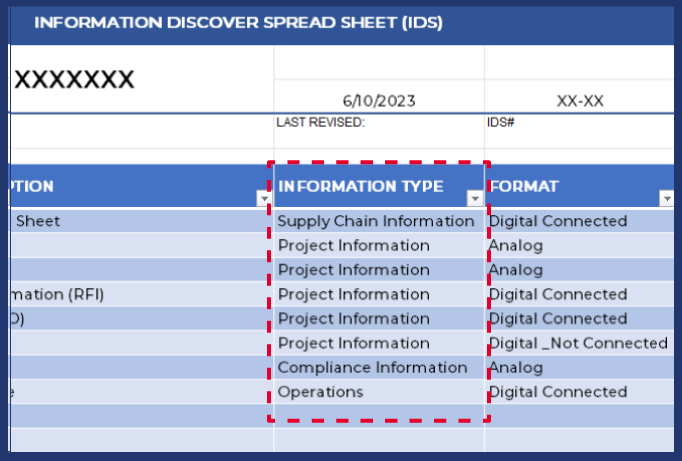Information Type
General
This field has a drop down for the parameters listed below. These represent commonly used parameter labels for data discovery but can be added to on the List Reference tab of the IDS.
Information Type
 In this field we are communicating the area of the business that the information most impacts or should most be associated to. This field will be helpful in understanding access level usage and security requirements for the information and for properly assigning oversight for that data. The types will also parallel closely to operational units in most construction companies.
In this field we are communicating the area of the business that the information most impacts or should most be associated to. This field will be helpful in understanding access level usage and security requirements for the information and for properly assigning oversight for that data. The types will also parallel closely to operational units in most construction companies.
Similar to "Naming / Description", "Information Type" is general in nature and represents large categories of information. If greater detail is required, it should be captured with additional documentation and following similar practices to "Naming / Description".
In this section we have provided information types. These types can be altered or added to. However, we recommend sticking to just these information types for the initial survey in the overall organizations IDS.
Best Practices
- Operations- This type of information is used in the day-to-day running of the business. It includes production schedules, work orders, inventory levels, machinery usage data, and quality control results.
- Financial Information- This includes all information related to financial transactions and fiscal management. Examples include sales, expenses, profit margins, tax records, invoices, payrolls, and more.
- Employee Information- This type of information relates to the workforce. It includes details such as employee names, contact information, job roles, hours worked, training records, and performance evaluations.
- Customer Information- This includes all information about clients, such as contact information, order history, feedback, and communication records.
- Supply Chain Information- This Information involves information about suppliers, material costs, delivery times, and inventory levels. This category should be for information that is company-wide not specific to a project.
- Project Information- This information is from individual projects, drawings, specifications, timelines, budgets, purchasing, resources used, milestones reached, and final outcomes. This is a large category and may contain several sub-types as a part of it including, operational, customer, and supply chain information.
- Compliance Information- This type of information helps to ensure that the company is following all necessary industry standards and regulations. It may include safety records, environmental impact data, and records of regulatory inspections or audits.
Understanding Good Stewardship
 What’s important to one person might not be important to someone else! Information type can help us understand who within our organization is likely to value the data so that important data is not excluded or ignored by those who do not require that type of information to do their job.
What’s important to one person might not be important to someone else! Information type can help us understand who within our organization is likely to value the data so that important data is not excluded or ignored by those who do not require that type of information to do their job.

